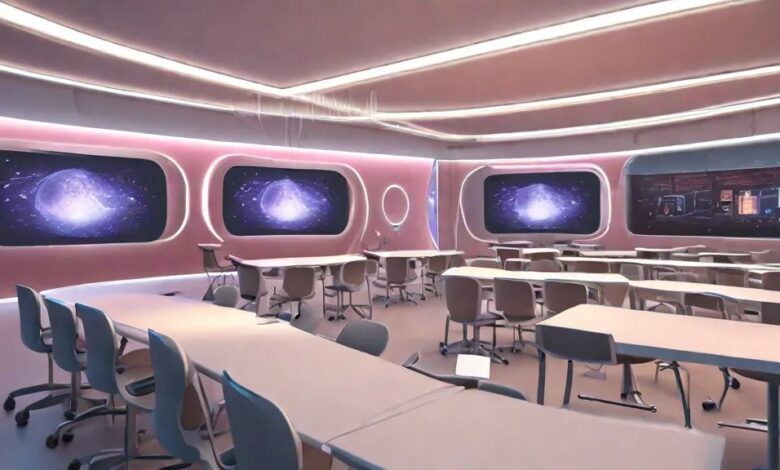Exploring the Design and Impact of Future Classrooms

1. Introduction to Future Classrooms
The future of education is central to the future of society, and the design of the modern high school in particular lags behind compared to the technological advances that have been made in recent decades. This can be observed through an examination of modern workplaces, which prioritize flexibility, intellectual conversation, and collaboration among peers. By contrast, existing schools are generally designed principally for teacher-directed instruction and individualized work. Teachers in the 21st century are recognizing that an engaging and collaborative environment is beneficial for the student experience, and they aspire to develop what might be called ‘Future Classrooms’. Future classrooms, in this sense, are typically understood as the latest generation of a constantly developing context for learning and teaching.
Classrooms of the future are likely to evolve with significant changes in furniture, resources and technologies, and interior design. The classroom’s layout can make a huge difference in how students are able to process information and fit the activities that engage them, and collaboration and conversation among individuals and groups are more likely. The move toward future environments suggests that instructional goals and outcomes will also change. This might include the development of non-discipline-specific skills like empathy and emotional intelligence. It might also involve a shift towards teaching interdisciplinary knowledge that can bolster employability due to ongoing automation. This essay examines the design of future classrooms, applies a socio-constructivist lens to the impact that future classroom designs are imagined to have, and discusses some implications of these considered impacts.
2. Innovative Technologies and Tools for Future Classrooms
With rapid advancements in technology, future classrooms are expected to be equipped with a broad array of tech-enablers, such as virtual and augmented reality, gamified learning modules, artificial intelligence (AI) to provide personalized education to every student, and employ apps for peer-to-peer learning.
Future classrooms can be physical, online, or blended spaces, as tools like augmented/virtual reality, 3D printing, and holograms redefine the meaning of presence – one no longer requires a concrete presence in a class to learn effectively. Furthermore, holographic imagery and simulators can substitute real-life resources, offering capabilities not available in the physical plane. At the same time, artificial intelligence (AI) can enable personalized learning experiences. Intelligent tools like bots and analytics can also enhance task completion and assessment processes.
The talk will also highlight the pedagogical changes that the increased digital engagement of students is projected to bring about in near-future classrooms. There are passive, active, and transformational levels of technology integration in classrooms. While at the passive level technology is used for one-way content delivery, at the active level, it enables a two-way interaction between teachers and learners. But the real change in pedagogy happens when technology is employed at the transformational level, where students interact with content, technology, teachers, and peers and learn how to use these fundamental skills to solve complex problems. Furthermore, the process can make learning more engaging and make professors and students more capable of questioning the validity of findings that purport to prove or disprove knowledge from diverse standpoints.
3. Pedagogical Approaches in Future Classrooms
Pedagogical Approaches
The pedagogical philosophy generally proposed by participants in the studies underpinning the design of the different future classroom types focuses on the needs of the learner. Student-centered pedagogies are built on the assumption that learning is an active and constructive process and that the responsibility for learning should reside with the student. Teachers in this context are seen as facilitators, who organize the learning content and tasks and provide guidance in reaching learning objectives. The different types of classrooms all facilitate collaboration to a certain extent, although areas in the literature allow in various degrees of guidance by the teacher. Embedded in collaborative learning designs is cooperation and active interaction with others towards the fulfillment of common goals and purposes.
Some features highlighted in relation to classroom designs link directly with the different collaborative learning strategies. Lemke (1998) identified that “The very shape of the classroom can send a strong message about what its occupants are expected and allowed to do,” showing the effect of seating arrangements on student participation. Classrooms must be constructed in such a way as to foster and support collaborative learning and active learning processes, and must make effective learning easier. Promoting engagement is seen as a requisite for a personalized learning approach. Students gain a degree of choice and freedom based on their needs and interests, and so classrooms need to be adaptable to suit the differing needs of the students at different times. Personalized learning space is essential for providing students with a sense of control over their learning which is an important psychological factor in motivation.
4. Assessment and Evaluation in Future Learning Environments
Assessment and evaluation are an integral part of the learning process. Instructors need to evaluate students to make instructional decisions, while students need feedback to direct their learning. In the school of the future, the way we assess and evaluate learning will most likely be different. We might use new techniques for assessment, such as adaptive assessment technologies which follow up a student’s correct answer with a more difficult question or a more complex scenario which allows us to dig deeper into a student’s understanding. We don’t necessarily measure a student’s attainment at a grade level, but instead delve into the depth and breadth of their understanding. We might also change what we are assessing – instead of assessing rote memory and fact recall, we might focus on 21st-century skills, such as collaboration, communication, creativity, problem-solving, flexibility, and global awareness.
From an institutional perspective, there are also other ways in which we will need to innovate with respect to the way academic staff are evaluated. The way teachers are evaluated, both from an administrative or student perspective, changes with the introduction of new educational paradigms. Institutions need to devise mechanisms to ensure that students’ feedback is in line with the learning objectives of a certain course, also focusing on evaluating the effectiveness of technologies that teachers will use. To sum up, the assessment and evaluation aspect of learning in the future school will call for a complete review of the criteria and evaluation perspectives being used – we will possibly advocate for an effective way to classify assessments and evaluation analyses, also promoting consistently valid and reliable standards for good assessment practice.
5. Challenges and Opportunities in Implementing Future Classrooms
The effective implementation of future classrooms will require clear and detailed design in terms of software, physical architecture, a pedagogical model that highlights peer instruction, teacher training processes, content creation, and the relation with co-curricular activities, administration patterns, short-term and strategic planning, and potential adaptations in national policy. These need to be coherently interconnected with the management patterns and information technology infrastructure to make the system work without central top-down command-and-control patterns. Independence is a key foundational principle for evolving educational processes, and teacher participation in design, management, and conduct of classes is crucial. The software design will require smooth audio-video and chat-window communication over the Internet.

The difficulties that might be faced include the high infrastructure requirements for managing multimedia classrooms, including a good space with audio-visual facilities; good connectivity and networking capacity; and capacitated teachers on information technology use and curriculum management. The microlevel challenges are in the software design for the immediate chats, trivia and polling, teacher signals for summative polls and knowledge construction activities, and server infrastructure security, reliability, scalability, distributive and administrative arrangements. If a unified mechanism can be accomplished, the system can bring in several positive benefits related to the creation management of large classes of students seldom attainable in an online Internet facility, operating on a just-in-time delivery model. Final examinations would still need to be fully proctored and invigilated to maintain their graded fairness, and tutorial groups of 25-30 students should be available to facilitate and administer ability dis-intensified collaborative problem-solving and project activities.







